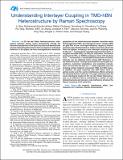| dc.contributor.author | Ding, Li | |
| dc.contributor.author | Ukhtary, Muhammad Shoufie | |
| dc.contributor.author | Chubarov, Mikhail | |
| dc.contributor.author | Choudhury, Tanushree H | |
| dc.contributor.author | Zhang, Fu | |
| dc.contributor.author | Yang, Rui | |
| dc.contributor.author | Zhang, Ao | |
| dc.contributor.author | Fan, Jonathan A | |
| dc.contributor.author | Terrones, Mauricio | |
| dc.contributor.author | Redwing, Joan M | |
| dc.contributor.author | Yang, Teng | |
| dc.contributor.author | Li, Mingda | |
| dc.contributor.author | Saito, Riichiro | |
| dc.contributor.author | Huang, Shengxi | |
| dc.date.accessioned | 2022-06-30T19:50:26Z | |
| dc.date.available | 2021-10-27T19:52:45Z | |
| dc.date.available | 2022-06-30T19:50:26Z | |
| dc.date.issued | 2018 | |
| dc.identifier.uri | https://hdl.handle.net/1721.1/133417.2 | |
| dc.description.abstract | © 2018 IEEE. In 2-D van der Waals heterostructures, interactions between atomic layers dramatically change the vibrational properties of the hybrid system and demonstrate several interesting phenomena that are absent in individual materials. In this paper, we have investigated the vibrational properties of the heterostructure between transition metal dichalcogenide (TMD) and hexagonal boron nitride (hBN) on gold film at low- and high-frequency ranges by Raman spectroscopy. Nineteen Raman modes have been observed from the sample, including a new interlayer coupling mode at 28.8 cm-1. Compared to reported experimental results of tungsten disulfide (WS2) on SiO2/Si substrates, the Raman spectrum for WS2 on hBN/Au emerges a blue shift of about 8 cm-1. Furthermore, a remarkable enhancement of Raman intensity can be obtained when tuning hBN thickness in the heterostructure. Through systematic first-principles calculations, numerical simulations, and analytical calculations, we find that the 28.8 cm-1 mode originates from the shearing motion between monolayer TMD and hBN layers. In addition, the gold substrate and hBN layers form an optical cavity and the cavity interference effects enhance the obtained Raman intensity. This paper demonstrates the novel vibrational modes of 2-D van der Waals heterostructure as an effective tool to characterize a variety of such heterostructures and reveals a new method to enhance the Raman response of 2-D materials. | en_US |
| dc.language.iso | en | |
| dc.publisher | Institute of Electrical and Electronics Engineers (IEEE) | en_US |
| dc.relation.isversionof | 10.1109/TED.2018.2847230 | en_US |
| dc.rights | Creative Commons Attribution-Noncommercial-Share Alike | en_US |
| dc.rights.uri | http://creativecommons.org/licenses/by-nc-sa/4.0/ | en_US |
| dc.source | other univ website | en_US |
| dc.title | Understanding Interlayer Coupling in TMD-hBN Heterostructure by Raman Spectroscopy | en_US |
| dc.type | Article | en_US |
| dc.contributor.department | Massachusetts Institute of Technology. Department of Nuclear Science and Engineering | en_US |
| dc.relation.journal | IEEE Transactions on Electron Devices | en_US |
| dc.eprint.version | Author's final manuscript | en_US |
| dc.type.uri | http://purl.org/eprint/type/JournalArticle | en_US |
| eprint.status | http://purl.org/eprint/status/PeerReviewed | en_US |
| dc.date.updated | 2021-08-11T16:01:22Z | |
| dspace.orderedauthors | Ding, L; Ukhtary, MS; Chubarov, M; Choudhury, TH; Zhang, F; Yang, R; Zhang, A; Fan, JA; Terrones, M; Redwing, JM; Yang, T; Li, M; Saito, R; Huang, S | en_US |
| dspace.date.submission | 2021-08-11T16:01:25Z | |
| mit.journal.volume | 65 | en_US |
| mit.journal.issue | 10 | en_US |
| mit.license | OPEN_ACCESS_POLICY | |
| mit.metadata.status | Publication Information Needed | en_US |
